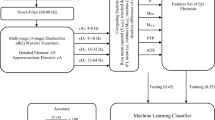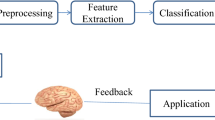Abstract
Hybridization in brain-computer interface (BCI) is an active research assessed by integrating more than two modalities to control multiple user commands and enhance the BCI performance. However, evaluation of these hybrid modalities is substantially challenging which necessitates robust techniques that can efficiently analyze the underlying dynamics of the brain signal. Fuzzy entropy based approaches are the objective measurements of evaluating the dynamic electroencephalography (EEG) complexity reflecting its ability to adapt to the variabilities of the brain. In this study, we proposed an empirical mode decomposition (EMD) featured fuzzy entropy method by applying coarse-graining to the time series signal at a multi-scale level (EMFuzzyEn) to efficiently discriminate the target and non-target events, and improve classification performance during simultaneous steady-state visual evoked potential (SSVEP) and rapid serial visual presentation (RSVP) BCI system framework. The proposed hybrid BCI framework with applied canonical correlation analysis (CCA) and EMFuzzyEn algorithm to the SSVEP and RSVP classifications achieved an offline accuracy of 87.41% for 12-channel combination and an online accuracy of 84.69% for 2-channel combination. The results demonstrated that the proposed algorithm enhanced the BCI performance by 5.85% (offline) and 6.78% (online) compared to our previous ERP-based classification results. Further, the EMFuzzyEn algorithm achieved highest classification accuracy across all channel combinations compared to the multi-scale fuzzy (MFuzzyEn) and non-fuzzy (ShEn, AppEn, CondEn) entropy algorithms. Overall, our empirical results confirmed that the proposed EMFuzzyEn algorithm significantly increased the EEG complexity during target tasks thereby enhancing the discrimination between target and non-target tasks, which might be a potential indicator to measure the brain dynamics and enhance the BCI performance.








Similar content being viewed by others
References
Nicolas-Alonso, L.F., Gomez-Gil, J.: Brain computer interfaces, a review. Sensors 12(2), 1211–1279 (2012)
Iturrate, I., Antelis, J.M., Kubler, A., Minguez, J.: A noninvasive brain-actuated wheelchair based on a P300 neurophysiological protocol and automated navigation. IEEE Trans. Robot 25, 614–627 (2009)
Placidi, G., Petracca, A., Spezialetti, M., Iacoviello, D.: A modular framework for EEG web based binary brain computer interfaces to recover communication abilities in impaired people. J. Med. Syst 40, 34–47 (2016)
Collinger, J.L., Wodlinger, B., Downey, J.E., Wang, W., Tyler-Kabara, E.C., Weber, D.J., McMorland, A.J., Velliste, M., Boninger, M.L., Schwartz, A.B.: High-performance neuroprosthetic control by an individual with tetraplegia. Lancet 381, 557–564 (2013)
Hortal, E., Planelles, D., Costa, A., Iánez, E., Úbeda, A., Azorín, J.M., Fernández, E.: SVM-based brain-machine Interface for controlling a robot arm through four mental tasks. Neurocomputing 151, 116 (2015)
Su, Y., Qi, Y., Luo, J.X., Wu, B., Yang, F., Li, Y., et al.: A hybrid brain–computer interface control strategy in a virtual environment. J. Zhejiang Univ. Sci. C 12, 351–361 (2011). https://doi.org/10.1631/jzus.C1000208
Teplan, M.: Fundamentals of EEG measurement. IEEE Meas. Sci. Rev. 2, 1–11 (2002)
Ignas, M., Robertas, D.: A prototype SSVEP based real time BCI gaming system. Comput. Intell. Neurosci. 2016, 15 (2016)
Chen, S.C., Chen, Y.J., Zaeni, I.A.E., et al.: A single-channel SSVEP-based BCI with a fuzzy feature threshold algorithm in a maze game. Int. J. Fuzzy Syst. 19, 553–565 (2017). https://doi.org/10.1007/s40815-016-0289-3
Orhan, U., Hild, K.E., Erdogmus, D., Roark, B., Oken, B., Fried-Oken, M.: RSVP keyboard: an EEG based typing interface. Proc IEEE Int Conf Acoust Speech Signal Process (2012). https://doi.org/10.1109/ICASSP.2012.6287966
Li, J., Ji, H.F., Cao, L., Zang, D., Gu, R., Xia, B., et al.: Evaluation and application of a hybrid brain computer interface for real wheelchair parallel control with multi-degree of freedom. Int. J. Neural Syst. 24, 1450014 (2014). https://doi.org/10.1142/S0129065714500142
Hong, K.S., Khan, M.J.: Hybrid brain–computer interface techniques for improved classification accuracy and increased number of commands: a review. Front. Neurorobot. 11, 35 (2017)
D. Sandeep Vara Sankar and L. -W. Ko. Evaluation of Fatigue and Attention Levels in Multi-target Scenario using CNN. 2020 International Computer Symposium (ICS), pp. 247–251 (2020)
Claudia, L., Hernandez, M.E., Weyhenmeyer, J., Sejnowski, T.J., Poizner, H.: Non-linear dynamical analysis of EEG time series distinguishes patients with Parkinson’s disease from healthy individuals. Front. Neurol. 4, 200 (2013)
Nakanishi, M., Wang, Y., Wang, Y.-T., Jung, T.-P.: A comparison study of canonical correlation analysis based methods for detecting steady-state visual evoked potentials. PLoS ONE 10(10), e0140703 (2015). https://doi.org/10.1371/journal.pone.0140703
Azami, H., Li, P., Arnold, S.E., Escudero, J., Humeau-Heurtier, A.: Fuzzy entropy metrics for the analysis of biomedical signals: assessment and comparison. IEEE Access 7, 104833–104847 (2019). https://doi.org/10.1109/ACCESS.2019.2930625
Cao, Z., Lai, K.-L., Lin, C.-T., Chuang, C.-H., Chou, C.-C., Wang, S.-J.: Exploring resting-state EEG complexity before migraine attacks. Cephalalgia 38(7), 1296–1306 (2018)
Cao, Z., et al.: Extraction of SSVEPs-based inherent fuzzy entropy using a wearable headband EEG in migraine patients. IEEE Trans. Fuzzy Syst. 28(1), 14–27 (2020). https://doi.org/10.1109/TFUZZ.2019.2905823
Dauwels, J., Vialatte, F., Musha, T., Cichocki, A.: A comparative study of synchrony measures for the early diagnosis of Alzheimer’s disease based on EEG. Neuroimage 49(1), 668–693 (2010)
Richman, J.S., Moorman, J.R.: Physiological time-series analysis using approximate entropy and sample entropy. Amer. J. Physiol. Heart Circ. Physiol 278, H2039–H2049 (2000)
González, C., Jensen, E., Gambús, P., Vallverdú, M.: Entropy Measures as descriptors to identify Apneas in Rheoencephalographic signals. Entropy 21(6), 605 (2019)
Chen, W., Wang, Z., Xie, H., Yu, W.: Characterization of surface EMG signal based on fuzzy entropy. IEEE Trans. Neural Syst. Rehabil. Eng. 15(2), 266–272 (2007). https://doi.org/10.1109/TNSRE.2007.897025
Cao, Z., Lin, C.-T.: Inherent fuzzy entropy for the improvement of EEG complexity evaluation. IEEE Trans. Fuzzy Syst. 26(2), 1032–1035 (2018)
Cao, Z., Ding, W., Wang, Y.-K., Hussain, F.K., Al-Jumaily, A., Lin, C.-T.: Effects of repetitive ssveps on eeg complexity using multiscale inherent fuzzy entropy. Neurocomputing (2019). https://doi.org/10.1016/j.neucom.2018.08.091
Hu, K., Ivanov, P.C., Chen, Z., Carpena, P., Stanley, H.E.: Effect of trends on detrended fluctuation analysis. Phys. Rev. E. 64, 011114 (2001)
D. S. V. Sankar and L. P. Roy. Principal component analysis (PCA) approach to segment primary components from pathological phonocardiogram. International Conference on Communication and Signal Processing, pp. 910–914 (2014)
Huang, N.E., et al.: The empirical mode decomposition and the Hilbert spectrum for nonlinear and non-stationary time series analysis. Proc. Roy. Soc. London A 454, 903–995 (1998)
Ko, L.-W., et al.: SSVEP-assisted RSVP brain-computer interface paradigm for multi-target classification. J. Neural Eng. (2020). https://doi.org/10.1088/1741-2552/abd1c0
Azadeh, M., Patrick, F., Pierre, B.: Trend filtering via empirical mode decompositions. Comput. Stat. Data Anal. 58, 114–126 (2013). https://doi.org/10.1016/j.csda.2011.05.015
Delorme, A., Makeig, S.: Eeglab: an open source toolbox for analysis of single-trial eeg dynamics including independent component analysis. J. Neurosci. Methods 134(1), 9–21 (2004)
Hong, K.S., Khan, M.J., Hong, M.J.: Feature extraction and classification methods for hybrid fNIRS-EEG brain-computer interfaces. Front. Hum. Neurosci. 12, 246 (2018)
Kalunga, E., Djouani, K., Hamam, Y., Chevallier, S., and Monacelli, E. SSVEP enhancement based on Canonical Correlation Analysis to improve BCI performances. 2013 Africon IEEE, pp. 1–5 (2013)
Li, F., Liu, T., Wang, F., et al.: Relationships between the resting-state network and the P3: evidence from a scalp EEG study. Sci Rep 5, 15129 (2015). https://doi.org/10.1038/srep15129
Barbosh, M., Singh, P., Sadhu, A.: Empirical mode decomposition and its variants: a review with applications in structural health monitoring. Smart Mater. Struct. (2020). https://doi.org/10.1088/1361-665X/aba539
Bernhard, S., John, P., and Thomas, H. Logistic Regression for Single Trial EEG Classification. Advances in Neural Information Processing Systems 19: Proceedings of the 2006 Conference, MIT Press, pp.1377–1384 (2007)
Sha’Abani, M.N.A.H., Fuad, N., Jamal, N., Ismail, M.: kNN and SVM classification for EEG: a review. Springer Singapore, Singapore (2020)
Chang, C.C., Lin, C.J.: LIBSVM: a library for support vector machines. ACM Trans. Intell. Syst. Technol. (2011). https://doi.org/10.1145/1961189.1961199
Manyakov, N., Chumerin, N., Combaz, A., Van, H., M.: Comparison of classification methods for P300 brain-computer interface on disabled subjects. Comput. Intell. Neurosci. 2011, 519868 (2011). https://doi.org/10.1155/2011/519868
Sun, S., Zhang, C., Zhang, D.: An experimental evaluation of ensemble methods for EEG signal classification. Pattern Recogn. Lett. 28, 2157–2163 (2007). https://doi.org/10.1016/j.patrec.2007.06.018
Rätsch, G., Onoda, T., Müller, K.R.: Soft margins for AdaBoost. Mach. Learn. 42, 287–320 (2001). https://doi.org/10.1023/A:1007618119488
Koul, A., Becchio, C., Cavallo, A.: Cross-validation approaches for replicability in psychology. Front. Psychol. 9, 1117 (2018)
Vanegas, M.I., Blangero, A., Kelly, S.P.: Exploiting individual primary visual cortex geometry to boost steady state visual evoked potentials. J. Neural Eng. 10(3), 036003 (2013)
Madhale Jadav, G., Lerga, J., Štajduhar, I.: Adaptive filtering and analysis of EEG signals in the time-frequency domain based on the local entropy. EURASIP J. Adv. Signal Process 2020, 7 (2020)
Lin, C.Y., Lu, C.F., Lu, H.M., et al.: Using fuzzy classifier in ensemble method for motor imagery electroencephalography classification. Int. J. Fuzzy Syst. (2021). https://doi.org/10.1007/s40815-021-01108-8
Gazzaniga, M., Doron, K., Funk, C.: Looking toward the future: perspectives on examining the architecture and function of the human brain as a complex system. Cognit. Neurosci. IV 15, 1245–1252 (2010)
Raghu, S., Sriraam, N., Kumar, G.P., Hegde, A.S.: A novel approach for real-time recognition of epileptic seizures using minimum variance modified fuzzy entropy. IEEE Trans. Biomed. Eng. 65(11), 2612–2621 (2018). https://doi.org/10.1109/TBME.2018.2810942
Mingai, L., Ruotu, W., Jinfu, Y., Lijuan, D.: An improved refined composite multivariate multiscale fuzzy entropy method for MI-EEG feature extraction. Comput. Intell. Neurosci. (2019). https://doi.org/10.1155/2019/7529572
Kosmyna, N., Lindgren, J.T., Lécuyer, A.: Attending to visual stimuli versus performing visual imagery as a control strategy for EEG-based brain-computer interfaces. Sci. Rep. 8, 13222 (2018). https://doi.org/10.1038/s41598-018-31472-9
Qi, Z.: An improved similarity measure for generalized trapezoidal fuzzy numbers and its application in the classification of EEG signals. Int. J. Fuzzy Syst. 23, 890–905 (2021). https://doi.org/10.1007/s40815-020-01043-0
Grassberger, P., Procaccia, I.: Estimation of the Kolmogorov entropy from a chaotic signal. Phys. Rev. A 28(4), 2591–2593 (1983)
Pincus, S.M.: Approximate entropy as a measure of system complexity. Proc. Natl. Acad. Sci. 88(6), 2297–2301 (1991)
Kosko, B.: Fuzzy entropy and conditioning. Inf. Sci. 40(2), 165–174 (1986)
Zadeh, L.A.: Fuzzy sets. Inf. Control 8, 338–353 (1965)
Acknowledgements
The current study was supported in part by the Ministry of Science and Technology (MOST) under Grants 108-2221-E-009-045-MY3, 110-2321-B-010-005, and 111-2321-B-A49-004, and supported in part by the Center for Intelligent Drug Systems and Smart Bio-Devices (IDS^2B) from the Featured Areas Research Center Program within the framework of the Higher Education Sprout Project by the National Yang Ming Chiao Tung University (NYCU) and Ministry of Education (MOE) in Taiwan.
Author information
Authors and Affiliations
Corresponding author
Appendices
Appendix A
Theorem
For a given time series \({\{X}_{i }:1\le i\le N\},\) given \(d, n\) and\(r\), the entropy of the sequence when fuzziness is incorporated is\(\mathrm{FuzzyEn}=\mathrm{ln}({\Phi }_{\left\{\mathrm{d}+1\right\}})-\mathrm{ln}({\Phi }_{\left\{\mathrm{d}+1\right\}})\).
Proof
Let \({A}_{ji}\) denote the number of vectors of \(d\) dimension \({Z}_{j\{d\}}\) within \(r\) of \({Z}_{i\{d\}}\) and \({B}_{ji}\) denote the number of vectors of \(d+1\) dimension \({Z}_{j\{d+1\}}\) within \(r\) of \({Z}_{i\{d+1\}}\).
Given \(n\) and \(r\), the probability of difference between any two vectors \({Z}_{j\{d\}}\) and \({Z}_{i\{d\}}\) that lies within \(r\) denoted by \({D}_{ji\{d\}}\) is defined as \({D}_{ji\left\{d\right\}}\) = \({A}_{ji}/(N-d)\).
Similarly, the probability of difference between any two vectors \({Z}_{j\{d+1\}}\) and \({Z}_{i\{d+1\}}\) that lies within \(r\) denoted by \({D}_{ji\left\{d+1\right\}}\) is defined as \({D}_{ji\left\{d+1\right\}}\) = \({B}_{ji}/(N-d+1)\).
Then, from the work of Grassberger et al. [50], the function \({\Phi }_{\left\{\mathrm{d}\right\}}\) and \({\Phi }_{\left\{\mathrm{d}+1\right\}}\) are called the average of the natural logarithms of functions \({D}_{ji\left\{d\right\}}\) and \({D}_{ji\left\{d+1\right\}}\) which are denoted by
With sufficiently large \(N\) value the above equations can be approximated to
From Pincus work [51], the calculation of difference between \({\Phi }_{\left\{\mathrm{d}\right\}}\) and \({\Phi }_{\left\{\mathrm{d}+1\right\}}\) for fixed parameters \(d, r\) and \(N\) provide inherent measure of regularity and complexity, which is often named as entropy.
Similarly, the equation \(\mathrm{FuzzyEn}=\mathrm{ln}({\Phi }_{\left\{\mathrm{d}+1\right\}})-\mathrm{ln}({\Phi }_{\left\{\mathrm{d}+1\right\}})\) gives
that is equal to the average of the negative natural logarithm over i \(-\mathrm{ln}({{B}_{ji}/A}_{ji})\).
Hence, the ratio \({{[B}_{ji}/A}_{ji}]\) represents an entropy.
Appendix B
Pseudocode of multi-scale EMD fuzzy entropy algorithm.
2.1 Required
Preprocessed EEG signal X ϵ RN×C, N = data length, C = number of channels, τ = scale-factor, r = width and n = gradient of the fuzzy function.
2.2 Pseudocode

Rights and permissions
About this article
Cite this article
Diddi, S.V.S., Ko, LW. Course-Grained Multi-scale EMD Based Fuzzy Entropy for Multi-target Classification During Simultaneous SSVEP-RSVP Hybrid BCI Paradigm. Int. J. Fuzzy Syst. 24, 2157–2173 (2022). https://doi.org/10.1007/s40815-022-01268-1
Received:
Revised:
Accepted:
Published:
Issue Date:
DOI: https://doi.org/10.1007/s40815-022-01268-1




